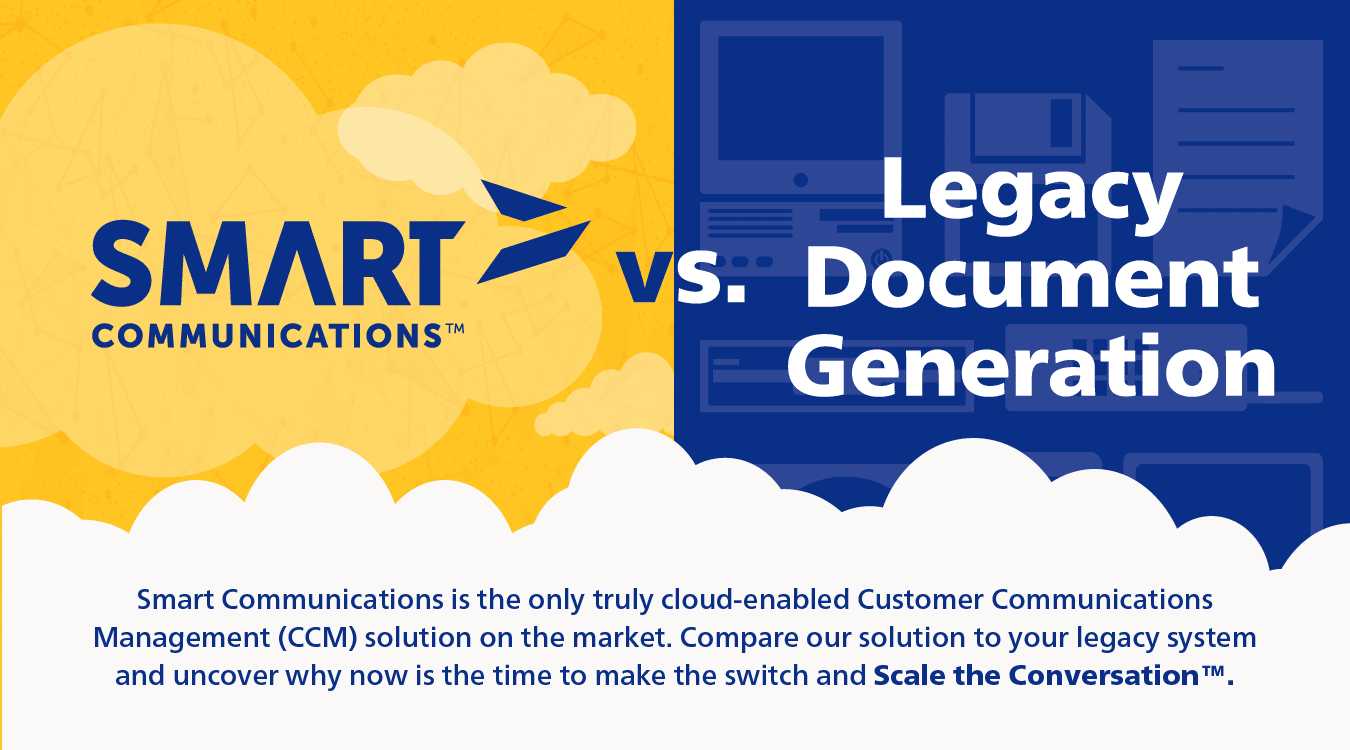
Smart Communications
Legacy Document Generation Systems
Improve Time to Market
Empowers your business users to make changes within hours, sometimes in minutes, rather than days or weeks going through IT.
Slower to implement, and present more obstacles to getting new product communications out quickly.
Eliminate Increasing Maintenance Charges
Because maintenance fees are built into the annual subscription fees, users are not faced with signi cant annual increases.
Some legacy customers see maintenance fees rise annually, up to a double digit percentage increase each year. Additionally, users must purchase upgrade packages and install them. This means yet another trip back to IT for help before getting those communications out.
Upgrade Process
Upgrades are built into the service, so they require minimal cost and resources.
Force enterprises to coordinate hardware, software, and version control to deploy an upgrade. Associated upgrade costs range from $100k – $400k.
Reduces IT Infrastructure Costs Via the Cloud
Migrating customer communications to the cloud typically saves users $300,000 in hardware, software, and environmentals.
Legacy systems were not built for the cloud and require costly infrastructure to run.
Reduces Labor Costs
Reduces the number of templates that an enterprise needs by 60 to 90%, making business users much more efficient and productive in communicating with customers.
Proliferate the number of templates as branded communications are managed on a per template basis, reducing efficiency.
Evolving From Print to Digital
Enables enterprises to increase the number of documents sent by email rather than regular mail 40% by the third year.
Slow down the process of digital channel adoption due to the “print rst” mentality and architecture.
Deployment Flexibility
The only enterprise-class solution listed as a Leader on Gartner’s CCM Magic Quadrant that o ers full cloud in a multi-tenant SaaS environment and hybrid-cloud deployment, giving enterprises unparalleled choice and control over where data is processed and managed.
Claim to have cloud, but are actually hosting their on-premise software in a non multi-tenant third party data center. Check by asking 3 questions:
1. Is your solution multi-tenant?
2. How are updates implemented?
3. What security accreditations does your solution have, e.g. Soc I, Soc II, HIPAA, PCI
Benefits for the Business User
Smart Communications
Legacy Document Generation Systems
Interactive Communications
Create, edit, and approve custom documents for any channel with a web- based interface using a zero footprint deployment model, making interactive customer service easy.
Rely upon third party components to deliver the interactive functionality, making it more dificult to get new features added to the solution.
Ease of Implementing Change
Enables business users to scale the change process by updating once using business user friendly tools for accelerated testing and release.
Unable to provide insight to business users about which of the thousands of templates (“compiled packages”) contain shared content, inhibiting the ability to make changes in a timely fashion.
Forms Support
Provides the ability to import and store existing PDF forms, including forms with mapped variables.
Require solution customization and recoding to allow the business user to overlay content on static forms.
Business Empowerment
A smart, intuitive interface that puts communications in the hands of the business user with minimal training required.
Built with user interfaces geared towards technical users, not business users, making it impossible for the business user to have independent, brand-managed control over customer communication.
Multi-channel Realtime Preview
Allows users to create mobile and digital-ready responsive templates designed to load optimally on any device.
Lack the exibility needed to serve today’s mobile consumers and unable to provide realtime previews.
Benefits for IT Teams
Smart Communications
Legacy Document Generation Systems
Modern CLOUD Architecture
Purpose-built for the cloud using modern architecture standards and recognized by Gartner for pioneering the CCM space in the Cloud. -Recognized by Gartner-
Architected as on-premise, print- rst solutions that are more di cult to enable for cloud deployment.
XML
Stores all assets as XML, the defacto standard for web-based architectures that’s machine readable and easily convertible.
Stores all assets as XML, the defacto standard for web-based architectures that’s machine readable and easily convertible.
Open Integration
Requires no customized code, designed for easy integration into contemporary enterprise architectures using a fully documented and versioned RESTful API interface.
Require custom code to integrate with other systems, extending the time to implement and integrate into enterprise environments.
Pre-integrated Solutions
Out-of-the-box adaptors/accelerators with enterprise CRM tools (Salesforce, Microsoft Dynamics) and Insurance solutions (Guidewire).
Require custom code to integrate with other systems.



